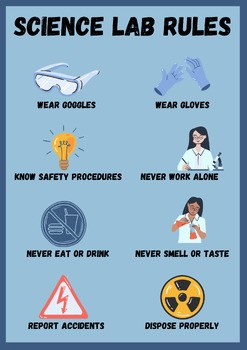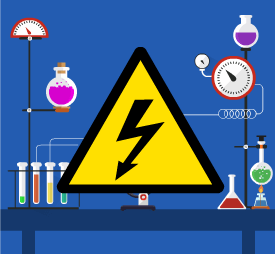- The process of creating a drug - May 23, 2023
- How do scientists model mental disorders in animals? - May 23, 2023
Laboratories are dynamic environments that require careful attention to safety procedures to prevent accidents, injuries, and exposure to hazardous materials. Whether you are working in a chemistry lab, biological lab, or any other type of research facility, it is important to understand the general safety precautions that can help you stay safe and protect those around you. In this topic, we will explore some of the key safety measures that are essential for anyone working in a laboratory setting, including the proper use of personal protective equipment, safe handling and storage of chemicals, and emergency protocols in the event of an accident or spill. We will also discuss the importance of ongoing safety training and education to maintain a culture of safety in the lab. By following these guidelines and best practices, you can help ensure a safe and productive working environment for all.

Personal Protective Equipment
Personal Protective Equipment (PPE) is one of the most important safety measures in a laboratory. Proper use of PPE can prevent exposure to hazardous chemicals, biological agents, and physical hazards. Depending on the nature of the research being conducted, PPE may include gloves, safety glasses or goggles, face shields, lab coats or aprons, and respirators. It is important to wear the appropriate PPE for the task at hand, and to ensure that it is properly fitted, maintained, and disposed of after use.
Chemical safety

Chemical safety is of paramount importance in a laboratory environment. Chemicals can pose a wide range of risks, including toxicity, corrosiveness, flammability, and reactivity. To minimize the risk of accidents and injury, it is important to follow established chemical safety rules and precautions. Here are some key chemical safety rules and precautions that should be observed in a laboratory:
- Know your chemicals: Before using any chemical in the laboratory, make sure to familiarize yourself with its properties, hazards, and recommended handling procedures. Always read and follow the manufacturer’s instructions, as well as any safety data sheets (SDS) that accompany the chemical.
- Proper storage: Store chemicals in the appropriate location, such as in a chemical storage cabinet or in designated areas, and separate incompatible chemicals to prevent potential reactions.
- Proper labeling: All chemical containers should be clearly labeled with the name of the chemical, its hazards, and the date it was received. Never use a chemical if the label is missing or unclear.
- Personal protective equipment (PPE): Always wear appropriate PPE, such as gloves, safety glasses, and lab coats or aprons, when handling chemicals. Use respiratory protection when necessary, such as when working with volatile or toxic chemicals.
- Ventilation: Use a fume hood or other ventilation system to remove hazardous vapors and gases from the laboratory. Ensure that the fume hood is functioning properly before use.
- Handling procedures: Always handle chemicals with care and in accordance with established procedures. Avoid splashing, spilling, or inhaling chemicals. Never pipette by mouth, and never eat or drink in the laboratory.
Electrical safety
Electrical safety is an important aspect of laboratory safety as electrical hazards can cause serious injury, electrical shock, or even death. Here are some safety precautions for electrical safety in the laboratory:

- Always inspect equipment before use: Before using any electrical equipment, make sure to inspect it for any signs of damage, such as frayed cords or loose connections. If you notice any damage, report it to the supervisor immediately and do not use the equipment.
- Use equipment properly: Follow the manufacturer’s instructions for using the equipment, and do not use it for a purpose for which it is not intended. For example, do not use an extension cord for a piece of equipment that requires a direct electrical connection to a power outlet.
- Use grounded outlets: Always plug electrical equipment into a grounded outlet to prevent electrocution. If you are using equipment that requires a three-pronged plug and the outlet is only two-pronged, use an adapter to ground the equipment.
- Do not overload circuits: Avoid overloading circuits by plugging too many pieces of equipment into a single outlet. This can cause overheating and potentially start a fire. If you need to use multiple pieces of equipment, use a power strip with built-in surge protection.
- Keep liquids away from electrical equipment: Liquids are conductive and can cause a short circuit or electrical shock. Keep all liquids away from electrical equipment and avoid using equipment with wet hands or in wet conditions.
- Never touch electrical equipment with wet hands: Wet hands increase the conductivity of the human body, which can lead to electrocution. Always dry your hands before using electrical equipment.
- Use a circuit breaker: Install a circuit breaker or ground-fault circuit interrupter (GFCI) in areas where electrical equipment is used. These devices can prevent electrical shock by detecting electrical faults and tripping the circuit.
By following these safety precautions, you can minimize the risk of electrical hazards in the laboratory and help ensure a safe working environment. Remember to always be aware of the electrical hazards around you and report any issues or concerns to your supervisor immediately.
Conclusion
In the event of an accident or spill, it is important to follow emergency protocols and procedures. This may include evacuating the area, alerting others, and contacting emergency services. Be familiar with the location of emergency equipment such as fire extinguishers, eyewash stations, and first aid kits, and know how to use them. Regular safety training and education is essential to maintain a culture of safety in the lab and to ensure that all researchers are aware of the latest safety guidelines and procedures.
By following these essential safety precautions, researchers and scientists can help ensure a safe and productive working environment in the laboratory. Remember, laboratory safety is everyone’s responsibility, and it is up to each individual to take the necessary precautions to protect themselves and others.

